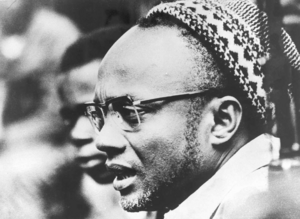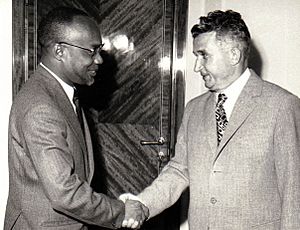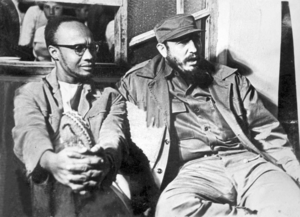Amílcar Cabral facts for kids
Quick facts for kids
Amílcar Cabral
|
|
|---|---|

Cabral wearing a traditional skullcap known as a sumbia during the 1964 Cassacá Congress, a gathering of PAIGC cadres.
|
|
| Personal details | |
| Born |
Amílcar Lopes da Costa Cabral
12 September 1924 Bafatá, Portuguese Guinea |
| Died | 20 January 1973 (aged 48) Conakry, Guinea |
| Cause of death | Assassination |
| Resting place | Amílcar Cabral's Mausoleum |
| Political party | African Party for the Independence of Guinea and Cape Verde; People's Movement for the Liberation of Angola |
Amílcar Lopes da Costa Cabral (Portuguese: [ɐˈmilkaɾ ˈlɔpɨʃ kɐˈβɾal]; 12 September 1924 – 20 January 1973) was a very important leader in Africa. He fought for countries to become free from colonial rule. He was an agricultural engineer, a political organizer, and a diplomat. He also believed in Pan-Africanism, which means uniting all African people. He was a revolutionary thinker and a poet.
Cabral was also known by the name Abel Djassi. He led the movement for independence in Guinea-Bissau and the Cape Verde Islands. He was killed on January 20, 1973. This was about eight months before Guinea-Bissau declared its independence. His ideas inspired many people fighting for freedom around the world.
Contents
Early Life and Education
Amílcar Cabral was born on September 12, 1924. He was born in Bafatá, which was then called Portuguese Guinea. This area is now part of modern-day Guinea-Bissau. His parents were from Santiago, Cape Verde. His father came from a wealthy family. His mother worked hard to support the family. She was a shop owner and hotel worker.
Cabral went to secondary school in Mindelo, Cape Verde. Later, he studied at the Instituto Superior de Agronomia in Lisbon, Portugal. While studying in Lisbon, he started student groups. These groups worked against Portugal's ruling dictatorship. They also promoted independence for African colonies.
After returning to Africa in the 1950s, Cabral helped promote independence. In 1953, he traveled over 60,000 kilometers. He was doing an agricultural survey in Portuguese Guinea. This helped him learn a lot about the people and the land. This knowledge was very useful for the guerrilla war he would later lead.
In 1956, he helped create the PAIGC. This stands for the African Party for the Independence of Guinea and Cape Verde. He also helped found the People's Movement for the Liberation of Angola (MPLA) that same year. He met other Angolan nationalists like Agostinho Neto in Portugal.
Leading the Fight for Independence

From 1963 until he was killed in 1973, Cabral led the PAIGC's guerrilla movement. They fought against the Portuguese government in Portuguese Guinea. This became one of the most successful independence wars in Africa. The main goal was to gain freedom for both Portuguese Guinea and Cape Verde. As the movement took control of land, Cabral became the leader of a large part of what is now Guinea-Bissau.
Cabral prepared his fighters for the independence war. He set up training camps in Ghana with permission from Kwame Nkrumah. He taught his leaders how to talk to people effectively. This helped them get support from local Guinean leaders for the PAIGC. Cabral knew his troops needed food to keep fighting. He also knew they had to learn to live off the land.
As an agricultural engineer, he trained his soldiers to teach farmers better techniques. This helped increase food production. It ensured that families, communities, and soldiers had enough to eat. When they were not fighting, PAIGC soldiers worked in the fields with the local people.
Cabral and the PAIGC also created a special trade system. It moved around the country. This system made basic goods available to people in the countryside. The prices were lower than those of colonial stores. During the war, Cabral also set up mobile hospitals. These hospitals gave medical care to wounded PAIGC soldiers. They also provided care to the general population. They got medical supplies from the USSR and Sweden.
His Death
In 1972, Cabral started to form a People's Assembly. This was to prepare for Guinea-Bissau's independence. However, on January 20, 1973, he was shot and killed in Conakry. He was killed by Inocêncio Kani, a former PAIGC member, and another member. The plan might have been to arrest him, but he was killed when he resisted.
After his death, about one hundred PAIGC officers and soldiers were accused of being involved. They were quickly executed. His half-brother, Luís Cabral, became the leader of the party in Guinea-Bissau. He later became the President of Guinea-Bissau.
Less than a month after Cabral's death, the United States stated that Portugal was not directly involved. However, they also said that Portugal's involvement "cannot be ruled out."
On April 25, 1974, the Carnation Revolution happened in Portugal. This led to a ceasefire in the wars. Eventually, all of Portugal's former colonies in Africa gained independence. Sadly, Cabral was killed before he could see his homelands of Cape Verde and Guinea-Bissau become free.
Honoring Amílcar Cabral


...one of the most lucid and brilliant leaders in Africa, Comrade Amílcar Cabral, who instilled in us tremendous confidence in the future and the success of his struggle for liberation.
— Fidel Castro, Tricontinental Conference 1966 in Havana, Cuba
Amílcar Cabral is seen as a very important revolutionary thinker. His ideas influenced people far beyond Africa. The Amílcar Cabral International Airport in Cape Verde is named after him. It is the main international airport in Sal. There is also a football competition called the Amílcar Cabral Cup.
The only private university in Guinea-Bissau is named after him. It is called Amílcar Cabral University, located in Bissau. Many books have been written about his life and work. For example, António Tomás wrote O Fazedor de Utopias: Uma Biografia de Amílcar Cabral. Patrick Chabal also wrote Amílcar Cabral: Revolutionary Leadership And People's War.
A housing estate in Monrovia, Liberia, is named Amílcar Cabral. There is also a block of flats in west London called Amílcar Cabral Court. The Angolan singer David Zé wrote a song called 'Quem Matou Cabral' in his honor. In 1978, East Germany issued a postage stamp with his picture. A square in Moscow was named "Amílcar Cabral Square" in 1974. In a 2020 poll by BBC World History Magazine, he was voted the second greatest leader in the world.
Writings
- Cabral, Amilcar. Resistance and Decolonization. Translated by Dan Wood. Rowman & Littlefield International, 2016.
- Cabral, Amilcar. Return to the Source: Selected Speeches of Amilcar Cabral. Monthly Review Press, 1973.
- Cabral, Amilcar. Unity and Struggle: Speeches and Writings of Amilcar Cabral. Monthly Review Press, 1979.
See also
 In Spanish: Amílcar Cabral para niños
In Spanish: Amílcar Cabral para niños


